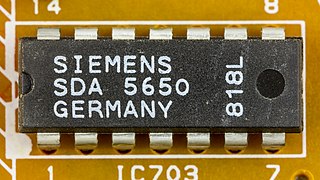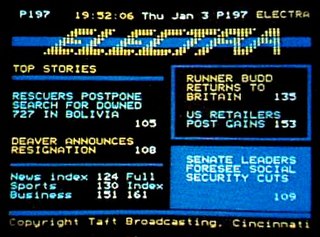
Closed captioning (CC) and subtitling are both processes of displaying text on a television, video screen, or other visual display to provide additional or interpretive information. Both are typically used as a transcription of the audio portion of a program as it occurs, sometimes including descriptions of non-speech elements. Other uses have included providing a textual alternative language translation of a presentation's primary audio language that is usually burned-in to the video and unselectable.
NAPLPS is a graphics language for use originally with videotex and teletext services. NAPLPS was developed from the Telidon system developed in Canada, with a small number of additions from AT&T Corporation. The basics of NAPLPS were later used as the basis for several other microcomputer-based graphics systems.

Telidon was a videotex/teletext service developed by the Canadian Communications Research Centre (CRC) during the late 1970s and supported by commercial enterprises led by Infomart in the early 1980s. Most work on the system ended after 1985, having failed to build critical mass.

Programme delivery control (PDC) is specified by the standard ETS 300 231, published by the European Telecommunications Standards Institute (ETSI). This specifies the signals sent as hidden codes in the teletext service, indicating when transmission of a programme starts and finishes.

In a raster scan display, the vertical blanking interval (VBI), also known as the vertical interval or VBLANK, is the time between the end of the final visible line of a frame or field and the beginning of the first visible line of the next frame or field. It is present in analog television, VGA, DVI and other signals. Here the term field is used in interlaced video, and the term frame is used in progressive video and there can be a VBI after each frame or field. In interlaced video a frame is made up of 2 fields. Sometimes in interlaced video a field is called a frame which can lead to confusion.

EIA-608, also known as "Line 21 captions" and "CEA-608", is a standard for closed captioning for NTSC TV broadcasts in the United States, Canada and Mexico. It was developed by the Electronic Industries Alliance and required by law to be implemented in most television receivers made in the United States.
Datacasting is the transmission of data over a wide area using radio waves. It typically refers to supplemental information sent by television stations alongside digital terrestrial television (DTT) signals. However, datacasting can also be applied to digital data signals carried on analog TV or radio broadcasts.
MovieBeam was a video on demand service started by The Walt Disney Company, specifically its subsidiary Buena Vista Datacasting, LLC. Movies were sent wirelessly into the subscriber's home by embedding digital data (datacasting) within local Public Broadcasting Service (PBS) stations' analog TV (NTSC) broadcast to deliver the movies to a set-top box. The data was embedded using dNTSC technology licensed from Dotcast, and distributed to TV stations via National Datacast through the vertical blanking interval, the same method used to provide closed captioning. Up to ten new movies were delivered to the player each week. The player also contained free movie trailers, previews, and other extras.
NABTS, the North American Broadcast Teletext Specification, is a protocol used for encoding NAPLPS-encoded teletext pages, as well as other types of digital data, within the vertical blanking interval (VBI) of an analog video signal. It is standardized under standard EIA-516, and has a rate of 15.6 kbit/s per line of video. It was adopted into the international standard CCIR 653 of 1986 as CCIR Teletext System C.

Teletext, or broadcast teletext, is a standard for displaying text and rudimentary graphics on suitably equipped television sets. Teletext sends data in the broadcast signal, hidden in the invisible vertical blanking interval area at the top and bottom of the screen. The teletext decoder in the television buffers this information as a series of "pages", each given a number. The user can display chosen pages using their remote control. In broad terms, it can be considered as Videotex, a system for the delivery of information to a user in a computer-like format, typically displayed on a television or a dumb terminal, but that designation is usually reserved for systems that provide bi-directional communication, such as Prestel or Minitel.

Electra was a teletext service in the United States that was in operation from 1982 up until 1993, when it was shut down due to a lack of funding, and discontinuation of teletext-capable television sets by the only US television manufacturer offering teletext capability at the time, Zenith. It was owned, operated and maintained by Cincinnati-based Taft Broadcasting and Tulsa, Oklahoma-based Satellite Syndicated Systems (SSS), later known as Tempo Enterprises, in cooperation with cable/satellite TV station Superstation WTBS, who carried Electra's data on their vertical blanking interval. SSS's own TV network, the Satellite Program Network, carried the service before it was shut down in 1989. The service was also available to C-band satellite dish users via the Galaxy 1 and Satcom 3R satellites.
Guide Plus+, TV Guide On Screen, TV Guide Daily, TV Guide Plus+ and Guide Plus+ Gold or G-Guide are brand names for an interactive electronic program guide (EPG) system that is used in consumer electronics products, such as television sets, DVD recorders, personal video recorders, and other digital television devices. It offers interactive on-screen program listings that enable viewers to navigate, sort, select and schedule television programming for viewing and recording. The differing names are only used for marketing purposes – the entire system is owned by Rovi Corporation, the successor to Gemstar-TV Guide International. In 2016, Rovi acquired digital video recorder maker TiVo Inc., and renamed itself TiVo Corporation.

ExtraVision was a teletext service created and operated by the American television network CBS in the early to mid-1980s. It was carried in the vertical blanking interval of the video from local affiliate stations of the CBS network. It featured CBS program information, news, sports, weather, even subtitling for CBS programming. ExtraVision could also have its pages customized by the local affiliate station carrying it, for such things as program schedules, local community announcements, and station promotions. WGBH Boston, a pioneer in assisting the deaf and hard-of-hearing with closed captioning, also provided content for those audiences to ExtraVision and assisted in providing captioning for CBS programming via ExtraVision.
Intercast was a short-lived technology developed in 1996 by Intel for broadcasting information such as web pages and computer software, along with a single television channel. It required a compatible TV tuner card installed in a personal computer and a decoding program called Intel Intercast Viewer. The data for Intercast was embedded in the Vertical Blanking Interval (VBI) of the video signal carrying the Intercast-enabled program, at a maximum of 10.5 Kilobytes/sec in 10 of the 45 lines of the VBI.

World System Teletext (WST) is the name of a standard for encoding and displaying teletext information, which is used as the standard for teletext throughout Europe today. It was adopted into the international standard CCIR 653 of 1986 as CCIR Teletext System B.
In broadcasting, channel playout is the generation of the source signal of a radio or television channel produced by a broadcaster, coupled with the transmission of this signal for primary distribution or direct-to-audience distribution via any network. Such radio or television distribution networks include terrestrial broadcasting, cable networks, satellites, IPTV, OTT Video, point-to-point transport over managed networks or the public Internet, etc.

Ross Video Ltd is a privately held Canadian company that designs and manufactures equipment for live event and video production. Ross Video's headquarters and manufacturing operations are located in Iroquois, Ontario, Canada, while their R&D labs are in Ottawa, Ontario, Canada.

JTES, the Japanese Teletext Specification, is a protocol used for encoding teletext pages, as well as other types of digital data, within the vertical blanking interval (VBI) of an analog video signal in Japan. It was adopted into the international standard CCIR 653 of 1986 as CCIR Teletext System D.










